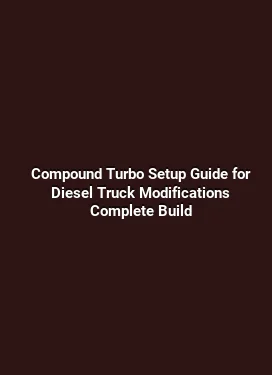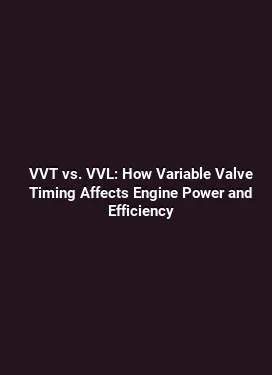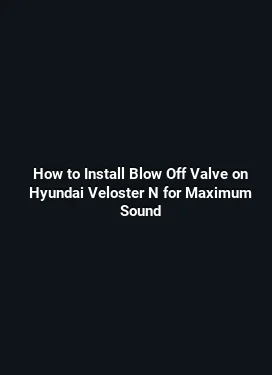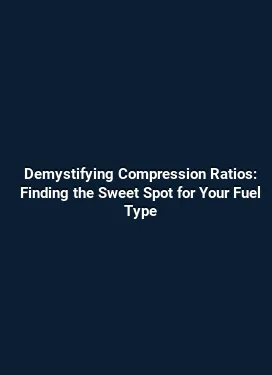The Science of Airflow: Optimizing Intake and Exhaust Manifold Design
Airflow is the lifeblood of engine performance. The journey of air from the intake system through the manifold, into the cylinders, and out through the exhaust defines how effectively an engine converts chemical energy into mechanical power. This article delves into the physics of airflow, detailing how intake and exhaust manifold geometry, runner lengths, port shapes, and collector designs influence pressure waves, mixing, and ultimately engine response. Readers will gain a practical understanding of how to apply these principles to real-world performance goals, from naturally aspirated setups to turbocharged and high-boost builds.
Fundamentals of Airflow Dynamics in Internal Combustion Engines

Airflow in an engine is governed by a mix of steady-state and transient phenomena. At low RPM, flow may resemble a quasi-steady process, but as the engine speed increases, pulsations become dominant. The key factors are pressure differentials, velocity profiles, and boundary layer effects. In a well-designed manifold, the objective is to minimize flow losses while maximizing charge delivery to each cylinder across the operating map. This involves managing velocity, impedance, and wave interactions that can either support or hinder volumetric efficiency.
Laminar and turbulent flow regimes play distinct roles in intake and exhaust paths. Turbulent mixing within plenums can enhance fuel-air homogeneity, while excessive turbulence in runners may induce pressure losses. The balance between smooth transport and controlled mixing is achieved through careful geometry and smooth transitions. In exhaust manifolds, the aim is to promote favorable scavenging while reducing back-pressure peaks that limit high-RPM performance. Understanding these dynamics is essential for rational design decisions rather than relying on trial-and-error tuning.
Laminar vs Turbulent Flow and its Relevance to Manifolds

Laminar flow offers predictability and low friction along a straight pathway, which is useful in sections of the intake where the air path is long and smooth. Turbulence, conversely, can enhance mixing and help distribute charge evenly at the port, but it also introduces minor energy losses. The challenge is to create segments within the manifold that encourage beneficial turbulent mixing where needed while preserving low-resistance flow in the primary path. Effective designs leverage transitions with smooth radii and avoid sudden changes that spike local losses. In exhaust manifolds, a controlled level of turbulence can improve scavenging—especially during the overlap period of valve timing—without incurring excessive back-pressure that blunts power output at high rpm.
Velocity profiling is another critical aspect. Higher velocity in runners can improve cylinder filling at lower to mid RPM by reducing boundary layer effects and ensuring a more uniform pressure distribution at the port. However, too much velocity can increase frictional losses and create acoustic resonances that distort the pressure waveform. The practical takeaway is to tailor runner diameter and length to the engine’s target operating range, creating a broadband impedance match that sustains efficient charging across RPM bands.
Intake Manifold Geometry: Plenum Shapes, Runner Length, and Radius
The intake manifold acts as the first major junction where the incoming air splits toward individual cylinders. The geometry of the plenum and the runners determines how pressure waves propagate, how evenly air is distributed, and how the system responds to transient demands during throttle modulation. Several design levers influence performance outcomes, including plenum volume, runner length, cross-sectional area, and the transitions between plenum and runners.
Plenum shape and volume are key to maintaining a stable pressure field at different engine speeds. A larger plenum can store more air, providing a buffer during rapid throttle changes, while a smaller plenum can reduce the volume that must be charged each cycle, enabling faster transient response. The compromise is a balance between peak flow capacity and throttle-tquenching lag, which becomes evident during rapid acceleration or deceleration events.
Runner length is perhaps the most talked-about parameter in performance tuning. Longer runners generally favor low- to mid-range torque by matching the impedance at those frequencies, while shorter runners promote higher-end power by aligning with the higher frequency content of the intake pulse at elevated RPM. Some modern designs employ equal-length runners to promote uniform distribution, while others use tuned length variants to bias the engine toward specific bands. The practical approach is to select a length that aligns with the engine’s intended operating window and then verify with flow simulations and dyno testing.
Radius transitions at the port entry influence how smoothly air accelerates into the runner. Abrupt corners cause boundary layer separation and localized energy losses. Gentle, gradually tapered transitions maintain higher pressure recovery, especially at higher flow rates. In addition, the cross-sectional area and shape of the runner—round versus oval, straight versus tapered—impact both the velocity profile and the frictional losses along the path. For engines running at high boost levels, attention to manifold materials and surface finish also plays a role in minimizing friction and thermal losses that can degrade volumetric efficiency.
Port and Runner Compatibility: Ensuring Seamless Flow
Compatibility between the intake port and the runner is essential for maximizing performance. Mismatches can create eddies and flow separation that reduce the effective cross-section and worsen flow coefficients. A well-matched routing minimizes dead zones and helps sustain a consistent charge across the entire RPM range. In practice, this means aligning the runner’s inner diameter with the port size, smoothing the junction with fillets, and using transitions that avoid sharp corners. In turbocharged applications, runner length may be tuned not only for volumetric efficiency but also to manage pressure wave timing relative to the turbine’s response characteristics.
Material choice and finish also influence flow. Copper and aluminum reflect typical manufacturing decisions, with surface finish affecting boundary layer behavior. Polished interiors reduce roughness-induced losses, while coatings may provide thermal advantages by limiting heat soak into the intake charge. These choices matter most at high speeds where even small losses can translate into measurable performance differences.
Exhaust Manifold Design: Collectors, Mergers, and Pulsatile Exhaust
The exhaust manifold is tasked with collecting high-velocity, pulsating exhaust pulses from multiple cylinders and merging them into a single flow path toward the turbocharger or exhaust system. The geometry determines how effectively pulses combine, how back-pressure is managed, and how the engine responds under rapid transients. Key design variables include collector geometry, runner arrangement, and the use of tuned length sections to sculpt pressure waves for scavenging benefits.
Collector design is central to how pulses from adjacent cylinders interact. Equal-length runners with symmetric collectors can promote even pressure sharing, while unequal-length designs may prioritize certain cylinders for a specific RPM range or torque curve. In high-performance exhaust systems, collectors are shaped to minimize flow separation and to encourage a coherent back-pressure wave that aids scavenging during valve overlap. The challenge lies in balancing the collector’s effective area with the need to avoid excessive back-pressure that would dampen engine response.
Runner arrangement—whether in a log, tri-Y, or short-tube configuration—affects how exhaust pulses merge and how thermal loads are distributed. Short tubes may improve high-RPM response, while longer tubes can enhance low-end torque by preserving pulse energy over a longer path. Modern designs often blend concepts, using a primary runner length to tune a broad operating range while leveraging collector geometry to refine the exhaust’s impedance at critical rpm bands.
In high-performance builds, engineers also consider anti-reversion features and acoustic tuning to manage unwanted resonances. Boundary layer control, scaffold-like supports, and attention to flange sealing are practical details that contribute to reliability under high heat and aggressive duty cycles. The interplay between exhaust back-pressure, turbocharger response, and overall engine efficiency is nuanced but tractable with a systematic design approach and iterative testing.
Turbocharger Compatibility and Pulse Tacing
For turbocharged engines, the exhaust manifold must work in concert with the turbine’s characteristics. The timing of pressure waves reaching the turbine inlet affects spool speed and transient boost. Tuned-length runners and properly sized primaries can align wave timing with the turbo’s lag profile, reducing turbocharger surge and improving throttle response. This kind of impedance matching is a practical pathway to delivering quicker throttle response without sacrificing peak power. It’s important to validate with both simulations and controlled road or dyno testing to confirm that theoretical gains translate into real-world performance.
Material and thermal management also play a role in turbine life and performance consistency. High-temperature alloys, proper heat shielding, and efficient routing minimize thermal distortion and ensure that the exhaust gas characteristics stay within predictable ranges. In turn, this supports stable turbo efficiency and extends the engine’s reliability envelope under demanding operating conditions.
Numerical Simulation and Experimental Validation
Advances in computational fluid dynamics (CFD) and experimental flow testing have made it feasible to predict manifold performance with greater confidence before prototyping. Simulations allow engineers to visualize pressure distributions, velocity fields, and potential boundary layer behavior across a wide range of operating conditions. These insights guide decisions about plenum volume, runner diameter, and transition radii, enabling a more targeted optimization process than traditional trial-and-error methods.
In practice, the design workflow often begins with a geometry concept, followed by 3D CFD analyses to assess static flow coefficients and transient response. Next, physical prototypes are manufactured and subjected to flow bench testing, which provides empirical data on airflow, pressure drop, and plenum behavior. The results are then correlated with engine dynamometer data to quantify improvements in volumetric efficiency, throttle response, and overall efficiency across the rpm range. This iterative loop—design, simulate, validate—helps ensure that theoretical advantages translate into measurable performance gains.
To maximize reliability, tests should cover both steady-state flow at representative speeds and transient maneuvers such as sudden throttle inputs and rapid decelerations. The goal is not only higher peak power but also improved responsiveness and consistent engine behavior in real-world driving scenarios. Engineers also use non-destructive testing methods to check for structural integrity, weld quality, and thermal stability under simulated long-term operation.
Practical Design Strategies for Performance Engines
Translating theory into practice involves a structured approach to manifold design, verification, and refinement. The following strategies offer concrete steps that engineers and enthusiasts can apply when aiming to optimize intake and exhaust performance without resorting to guesswork.
1) Define the operating window: Start by identifying the engine’s target RPM range and torque goals. Use this to set baseline runner lengths and plenum characteristics that favor the desired impedance matching across those speeds. This alignment helps ensure a strong, usable response in the places it matters most on the street or track.
2) Prioritize smooth transitions: Avoid sharp changes in cross-sectional area and abrupt corners at runner-to-plenum interfaces. Implement fillets and gradual radii to minimize boundary layer separation and frictional losses. Smooth transitions preserve pressure recovery and improve overall flow efficiency.
3) Optimize distributor strategy: For multi-cylinder layouts, consider equal-length runners to promote uniform cylinder filling and reduce yaw-induced imbalances. If using unequal lengths, verify that the differential aligns with the engine’s flow characteristics and the intended torque curve.
4) Tailor exhaust pulse management: In exhaust systems, design collectors and primary lengths to exploit beneficial pulse interactions while avoiding excessive back-pressure. Use simulation-guided decisions to balance high-RPM power with low-end torque, particularly in turbocharged configurations where the turbine’s behavior dominates part of the flow dynamics.
5) Leverage materials and finishes for thermal control: Thermal losses through the manifold can erode charge density and exhaust energy. Selecting materials with favorable thermal properties, applying protective coatings, and ensuring adequate heat shielding can help maintain consistent performance across temperatures and duty cycles.
6) Validate with a holistic testing plan: Combine CFD results with bench flow tests and engine dyno data. Look for consistent improvements in volumetric efficiency, throttle response, and efficiency across the operating map. Use this empirical feedback to iterate on geometry and transition details.
7) Consider practical manufacturing constraints: While complex geometries can deliver performance gains, they must be manufacturable at a reasonable cost and reliability level. Design for manufacturability, including production tolerances, weld quality, and assembly feasibility, ensures that the performance benefits can be realized in the field.
8) Integrate with auxiliary systems: Air intake filters, intercoolers, and turbocharger plumbing all influence the effective impedance seen by the manifolds. A holistic approach to system design helps avoid local optimization that could degrade overall performance. In some cases, minor changes in the intake tract can yield outsized gains when harmonized with the manifold’s impedance.
9) Monitor steady-state and transient metrics: Beyond horsepower, track metrics such as throttle response latency, minimum pumping losses, and the stability of the air charge under rapid throttle changes. These data points provide actionable feedback for further refinements and tuning.
10) Stay mindful of reliability and durability: High-performance designs must endure long-term operation under elevated temperatures and pressures. Stress analysis, corrosion considerations, and vibration tolerance are practical factors that influence the durability of intake and exhaust manifolds in race or sport applications.
Trend Keywords and Semantics
Incorporating trend terminology and semantically rich concepts helps content stay current and discoverable. Phrases like dynamic impedance matching, pulsating flow optimization, and boundary layer management describe the nuanced interplay of geometry, flow physics, and performance outcomes. While avoiding overly technical jargon in a reader-friendly piece, these terms anchor the discussion in established engineering principles and align with search intent for enthusiasts and professionals seeking actionable guidance.
Additionally, discussing operational strategies such as throttle-induced pressure fluctuations, resonance tuning, and impedance matching across rpm bands provides a semantic framework that resonates with readers interested in practical engineering decisions. The goal is to present a comprehensive, realistic view of how manifold design interacts with whole-engine performance, rather than isolating components from their systemic context.
Conclusion and Practical Takeaways
Airflow optimization through thoughtful intake and exhaust manifold design offers tangible benefits: more robust throttle response, improved low- and mid-range torque, and better high-end power without necessarily increasing pumping losses. By aligning plenum volume, runner length, and transition geometry with the engine’s operating window, and by carefully shaping exhaust collectors to manage pulsations, engineers can craft a pathway to meaningful performance gains. The fusion of simulation-driven insights with rigorous bench and dyno validation creates a robust design workflow that yields reliable, repeatable results in real-world driving conditions.






